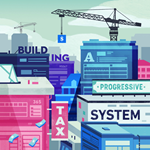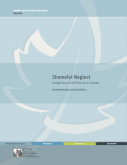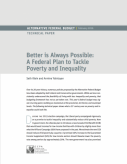Canada
Published on Mon, 2017-04-10 16:30
Men and women are different. That shouldn’t be news, but today it is. Today, the government released the first federal budget that includes a look at the differences between men and women. Differences like the fact that women are twice as likely to work part-time, do more hours of unpaid care work, are less likely to qualify for Employment Insurance and are more likely to be the victim of a violent crime. For public spending to be effective, we need policies and programs that respond to those differences. More targeted policy is more effective policy. Otherwise we could just divide up the budget by 37 million Canadians and send everyone a cheque. |
Published on Thu, 2017-02-09 19:36
As the Ontario and Quebec governments design their versions of a basic income pilot program, Canadians find themselves engaged in a policy question we haven’t grappled with in almost half a century: how should the welfare state evolve? At the heart of the basic income debate is a discussion about what’s required for everyone to have a basically decent life. Implicitly, it embraces a conversation about the importance of markets in that pursuit. |
Published on Mon, 2016-08-22 17:23
Canada's newly-elected federal Liberal government has committed to working towards achieving the goals set out in the 2030 Agenda “both at home and abroad.” However, the Government inherits a country that has been profoundly shaped by the conservative economic and social policies of the past decade. The new government will have to overcome the challenges posed by a much-diminished federal government, social and income inequality, and an economy based on growing wealth rather than wages in order to deliver on its commitment to achieving the Sustainable Development Goals. In sharp contrast to the previous federal Conservative government, the current government has committed itself to resumed deficit spending. However, even with the increases seen in their first budget, federal programme spending remains at a historic low. Today, federal programme spending as a share of the economy stands at 13 percent of GDP, its lowest point in the past 60 years. |
|
Canada’s newly-elected federal Liberal government has committed to working towards achieving the goals set out in the 2030 Agenda “both at home and abroad.” However, the government inherits a country that has been profoundly shaped by the conservative economic and social policies of the past decade. The new government will have to overcome the challenges posed by a much-diminished federal government, social and income inequality, and an economy based on growing wealth rather than wages in order to deliver on its commitment to achieving the Sustainable Development Goals.
|
Published on Fri, 2016-05-20 10:23
Canadian Centre for Policy Alternatives (CCPA) launches the report "Shameful Neglect: Indigenous Child Poverty in Canada". The report calculates child poverty rates in Canada, and includes the rates on reserves and in territories—something never before examined. The report also disaggregates the statistics and identifies three tiers of poverty for children in Canada, finding the worst poverty experienced by status First Nation children (51%, rising to 60% for children on reserve). The second tier encompasses other Indigenous children and disadvantaged groups (ranging from 22-32%), and the third tier consists of children who are non-Indigenous, non-racialized and non-immigrant, where the rate of 13% is similar to the OECD average. |
Published on Mon, 2016-03-07 14:05
The study Making Women Count. The Unequal Economics of Women’s Work, looks at how women in Canada and around the world are affected by rising inequality, including the burden of unpaid work, the undervaluing of work in predominantly female fields, and the unspoken social norms that see men offered higher wages and rates of promotion than women. Women make up some of the poorest and lowest paid workers in the global economy. And, as the report shows, women are doing more and more work to grow countries’ economies without seeing equal benefits. The study offers a number of solutions to help make women count, including a shift towards policies that support better wages and access to employment for women, better financial support of public services - like health and child care – to reduce the care burden on women, and a greater focus by governments to prioritize women’s rights. |
Published on Fri, 2016-02-19 10:39
During the 2015 federal election campaign, the Liberal party campaigned vigorously on a promise to tackle inequality and substantially reduce child poverty. Proposals such as the Canada Child Benefit and 10% increase to the Guaranteed Income Supplement (GIS) for low-income seniors are certainly steps in the right direction. However, the fight to eliminate poverty and inequality is far from over. These proposals in and of themselves are inadequate to accomplishing the task. This paper, which expands upon a chapter on poverty and inequality in the upcoming 2016 Alternative Federal Budget, proposes the terms of a comprehensive federal poverty reduction plan. If the government is serious about its campaign pledge to bring real economic opportunities to more people, the practical and affordable policy tools outlined here will take them some way toward that goal. |
Published on Fri, 2015-05-22 10:53
Simmering conflicts in higher education have reached the boiling point across Canada and around the globe. Teach-ins, occupations, strikes, and mass protests are being mobilized against exorbitant tuition fees, declining educational quality, mismanagement, the commodification of research, and the suppression of free speech and critical inquiry. A Penny For Your Thoughts, a new book from CCPA's Education Project, shows how Canadian higher education has come to this point. Through 17 real time studies, it tracks how the deteriorating condition of postsecondary education is rooted in corporatization, the process through which universities and colleges increasingly work for, with, and as businesses. The book’s central message is that the current state of Canadian universities is neither natural nor inevitable: it is the outcome of choices, policies, and actions that can be unmade and undone. Authors Claire Polster and Janice Newson do not prescribe easy recipes for achieving this. Instead, they help citizens to arrive at their own understandings of corporatization and to identify where and how they can intervene strategically in their local universities and communities to reverse its effects. By so doing, Canadians can reclaim their universities as public-serving institutions that realize their highest aspirations and meet their own, their fellow citizens’, and the global community’s most pressing needs. |
Published on Wed, 2015-04-22 12:50
Oil prices are down. Economic growth is down. Employment rates are stagnant. Household debt is climbing to record highs. Canadians could use a break. The 2015 federal budget has one for you. |
Published on Fri, 2014-08-29 12:00
The Prime Minister is wrapping up his ninth annual trip to Canada’s north this week. This year, like every year, the stealth ski-doo is loaded up with announcements. Presents for everyone! So what are women in Nunavut going to find in their stockings this year? The bulk of federal investments in economic development in the north are funnelled through the Canadian Northern Economic Development Agency, which has an annual budget of just over $50 million (although that number is projected to decline over the next few years). Much of that $50 million is currently directed towards resource development—training for folks to work in the resource sector, infrastructure to get to the resources, research to tell us where the resources are. |











